Reality Check: Those Mundane Movie Cheats That Shatter Your Suspension of Disbelief
From Batman's eye shadow to people doing fake over-steering in a car...
This article comes from Den of Geek UK.
My mother-in-law can’t stand men who sing with their eyes closed.
It completely ruins the experience of watching live music for her. I don’t know why – I have failed to grasp the precise psychological reason why a male vocalist shielding himself from the gaze of his audience using tightly scrunched eyelids should bother her so – but bother her it does. Doesn’t matter how well they sing; doesn’t matter how accomplished their band is: this tiny betrayal of the modicum of focus and effort needed to stay in key takes her right out of the moment.
But who am I to judge? The depth and breadth of seemingly innocuous things that nonetheless temporarily curtail the enjoyment I’m receiving from watching a film are worryingly myriad. We all have them – and they’re unique to our own sensibilities – but they all have the same effect: pulling you out of the movie.
For some it’s historical inaccuracy; others are triggered by cliché or illogical character choices. There are those that obsess over the unlikely financial circumstances that have allowed a modestly employed protagonist to afford such a luxurious apartment. A certain someone springs to mind who gets irritated when conveniently-cued video clips spout the necessary exposition to get a character up to speed.
For me, however, it’s small, seemingly mundane details that tap you on the shoulder and remind you that you’re only watching a movie because they don’t – or simply can’t – happen in real life. Artifice alerts, fiction flares, reality checks… call them what you will: they’re the little things that prick your suspension of disbelief for the most trivial of reasons. They’re not mistakes so much as cheats: wilful inconsistencies that are tolerated by filmmakers because they help propel the story, or cut down the running time, or flatter the star, or are simply too bothersome or troublesome to get right. Because who’s going to notice?
Me. I’m going to notice. Because I’ll believe a man can fly. I’m on board with your chest-bursting, acid-for-blood alien. I’ll even buy Gerard Butler as a satellite designer. But I will NOT tolerate a wireless Xbox controller being used to play a Nintendo console!
Here are some more examples. By the end of this you may feel my mother-in-law is perfectly reasonable by comparison…
The surprisingly effective gag
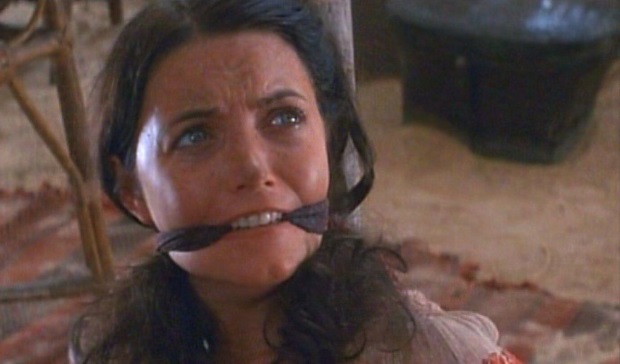
Not a joke that impresses you with the hilarity it induces. No, I’m talking about those instances where a strip of cloth tied tight around someone’s mouth renders them inexplicably mute.
Now I’m no expert in restraining and incapacitating, but on the very rare occasions when I’ve experimented with this method of vocal inhibition (don’t ask), a ribbon of rag does little to impede communication beyond having the gagged individual (no really, don’t ask) speak like an amateur ventriloquist. Diction may be hampered, but salient information can still be exchanged and very loud noises can still be made (please, I said don’t ask).
Yet in the movies this primitive attempt at enforced silence renders people almost entirely mute, able to generate no more than muffled grunts (see: Marion Ravenwood in Raiders Of The Lost Ark).
There’s this weird party game I played with my family last year where you have to put an elaborate mouth shield into your gob and try to repeat certain phrases to your team. And if my mom can understand me saying “Benedict Cumberbatch’s cabbage patch” while my lips and cheeks are being contorted like an Aardman character, then I’m fairly sure you need more than a handkerchief to stifle the flow of oral information.
The ridiculously under-steering vehicle
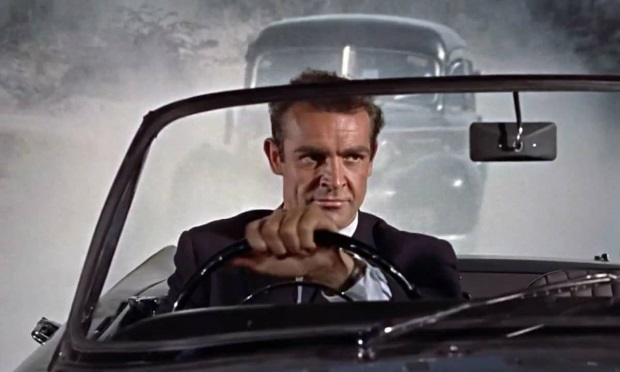
There are three main ways to create the illusion that a character in a movie is driving a car. 1) You project a video of the moving road on a green screen behind a stationary car. 2) You place a car on top of, or behind, another vehicle so that the car is being, in effect, towed. 3) You actually get the actor to drive a car and film him or her doing it. This third one isn’t strictly an illusion, I grant you.
But the point is, in those first two examples, the actor isn’t actually driving. That’s fine – thanks to the clever placement of cameras, the illusion is perfectly sound.
Well… it was until you started moving your fake steering wheel left and right like a crazy person enthralled by the bubble in a spirit level.
In real life such action would result in the vehicle veering left to right in a bizarre and dangerous snaking movement, and the occupants would constantly be thrown from one side to the other. Yet according to the view in the rear window, the car is travelling in a perfectly straight line on a long, straight highway with not even the slightest perceivable bend.
Maybe it’s because a lot of actors don’t drive in real life. Still, that’s no excuse; I mean they bring in experts to tell them how to fire a gun or hold a sword or ride a horse, so why can’t someone take five minutes out of their hectic schedule to inform the star of their movie that real cars don’t handle like the vehicles in Mario Kart?
Let’s be honest, the real reason this happens is because the perpetrator is “acting”. You can’t give an actor a prop and not expect him or her to interact with it in an actorly way. And if that means wildly rocking the steering wheel as if weaving through a set of tightly packed traffic cones, then so be it.
It does, however, take me out of the movie.
The unfathomably quick-talking phone caller
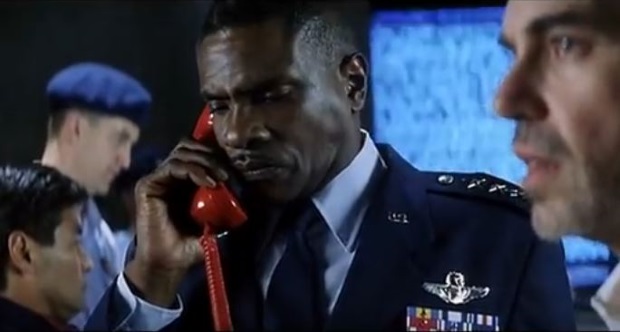
We’re with Detective Jack Pimlico. His phone rings. He answers it…
“Yeah, Pimlico here. What!? When? I’ll be right there.”
Pimlico hangs up. His companion looks concerned and asks what’s happened.
Pimlico then proceeds to explain who was calling and the convoluted situation that’s unfolding. Apparently the criminal he arrested earlier has managed to escape police custody whilst in transit to the local penitentiary and is currently holed up in an under-construction shopping mall where he has taken several hostages. He has gleaned all this information from A FIVE SECOND PHONE CALL where he was speaking for at least half the duration.
Sometimes I like to rewind and play back these exchanges and try to speak out loud what the caller must be saying, but it’s invariably impossible. On the few occasions the information can be imparted in time, it’s a frantic string of nouns and verbs devoid of a greeting, an indication of who’s calling, and a farewell. Something like: “Prisoner escaped! Hostages held! Mall downtown!” You know, like they’ve just woken from a psychic trance and are babbling the salient points of a vision they had.
Some people get annoyed when characters just hang up without saying goodbye, but rudeness doesn’t pull me out of a movie – data burst phone calls do.
The unfeasibly refreshed wake-up face
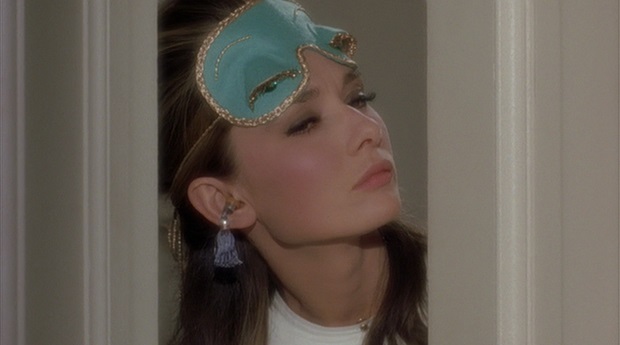
I considered including a photograph of my own bleary-eyed visage taken shortly after rousing to accompany this particular entry, but many people read this site in the morning over breakfast, or on a train during a commute – situations in which you really don’t want to encourage a gag reflex.
Most people look horrific first thing in the morning; if our sleep has been prematurely interrupted, we look even worse. As a general rule, women don’t go to bed with a decent amount of make-up on – and if they do, the majority is smeared across their faces and on the pillow when they eventually stir.
Look, I know movie production dictates that you can’t leave your actor on set to fall asleep, only to wake them 5 hours later and immediately shoot the required scene (although Mike Leigh probably does that). But can’t the handsomely-paid make-up artist at least make them look even vaguely awful? Slightly sticking up their hair doesn’t cut it, especially when it’s just the messed-up look I used to purposely try to recreate when fibre putty was invented. He’s acting tired… MAKE HIM LOOK TIRED!
If special effects can de-age Michael Douglas and Robert Downey Jr. by 30-odd years, then they can recreate the dark-ringed, crumpled-faced monstrosities that stare back from the bathroom mirror when everyone else is starved of somnolence. Because when an actor is disturbed by a phone call or alarm clock and looks either suspiciously fresh-faced or subtly made-up, all I can picture is the actor arriving on set 5 seconds earlier, just before the lights were turned off and the director shouted “Action!”
The miraculously vanishing superhero eye shadow
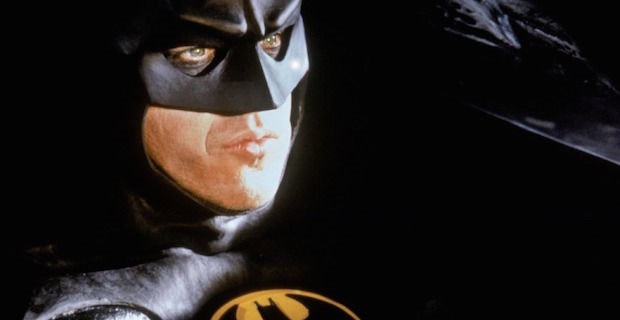
Batman Begins was supposed to be the “realistic” superhero film; the one that contextualised and explained the more fanciful elements of costumed vigilantism. But it still couldn’t bring itself to admit that the only way to approximate that comic book visual of the white eyes peering out from the dark cowl was to apply liberal amounts of black eye make-up.
It took an affectionate piss-take of the genre – Kick Ass – to finally be upfront about this cosmetic cheat, with Nic Cage’s Big Daddy sombrely applying the boot polish around his peepers before suiting up (although a memorable French & Saunders sketch predates even that).
Batman Returns has a quacking radar device in the Bat Boat, it has Catwoman shot four times at almost point-blank range and survive, it even has Wayne Manor set up to shine a giant bat symbol into Bruce’s lounge of choice should the city need him (which I think undermines his ability to keep a secret identity). I forgive all of that because it’s a highly stylized superhero fetish film. What I CAN’T forgive is that bit at the end when Batman reveals his identity to Catwoman. Because it cuts from him with eye make-up and cowl, to Michelle Pfeiffer looking perplexed (as well she might), to him in exactly the same position but WITHOUT eye make-up (which looks bloody weird) just so that when he dramatically rips off his rubber cowl he doesn’t look like a Robert Smith tribute act.
THAT, Tim Burton, is what took me out of your movie about a repressed orphan dressing up as a flying mouse to defeat a disfigured pervy bird man whose favoured methods of transportation include a flying umbrella and a giant motorised bath duck.
The suspiciously well-filmed footage
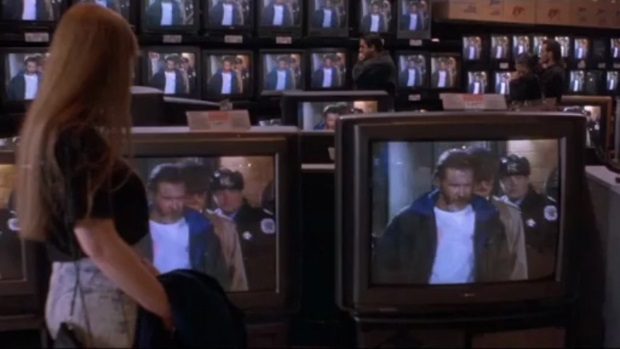
This one’s niche, but probably bothers me more than any of the others. It’s when a scene is required that features TV footage or security camera footage or amateur cameraman footage from an event that took place earlier in the movie. And instead of the production crew having the foresight to record this kind of footage on the days they actually filmed the scene in question, they decide to save a few bucks by using footage from the cutting room floor.
The thing is, movie footage is distinctly different to news reportage or security footage or something someone was supposed to have captured with a mobile phone. It doesn’t matter how many filters you apply, it’s highly unlikely that the CCTV camera was set up to accommodate the ‘rule of thirds’, let alone a dynamic tracking shot. And, oh hey – guess what? – you’ve pulled me out of the movie again…
There’s a bit in The Fugitive that always bugs me. During a montage, a bunch of people are watching store-front TVs showing news clips from the Kimble court case, and the footage features a dolly shot as the camera zooms straight into Harrison Ford’s face as he stands front of court – apparently receiving the verdict. Clearly that was shot for the actual film and ended up on the cutting room floor, but in recycling it for this purpose and slapping some news graphics over the top of it, the filmmakers would have me believe that a news camera crew were allowed to set up this dramatic swooping camera shot during this pivotal moment in court.
It gets worse when the same technique is applied to events that happened in a previous film from the series. Given that it’s less likely the production team even has access to that movie’s deleted scenes, actual sequences from the previous movie are used. A great example of this would be in The Fly II, when Eric Stoltz is conveniently filled in on his predicament when secret surveillance tapes of his father’s experiments (footage from the first film with a noise filter over it) are uncovered.
So those are just a handful of examples that really shouldn’t – but invariably do – bother me. Feel free to add your own sources of irritation in the comments below…